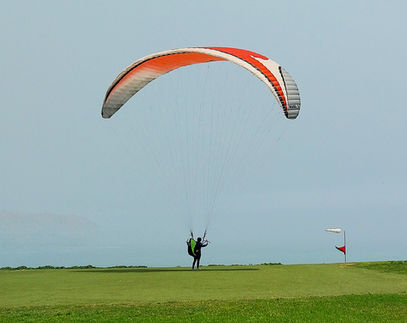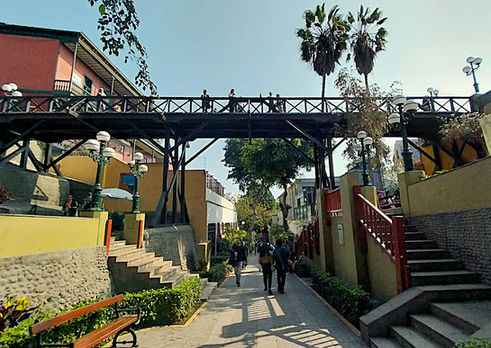
Lima
Peru
Like most tourists, we based ourselves in the Miraflores district of Lima, way down south near the coast. It was everything we imagined it to be. Modern restaurants, expensive bars, decent bakeries (finally!), horrendous traffic and continual noise. There were just as many casinos as there were beggars along the streets. Lima in general is quite spread out so walking everywhere isn't always an option, but I was happy to give it a shot.
Day 1 and the weather was against me. Low clouds and haze turned the city grey, which wasn't ideal for walking up and down the malecon along the coast. Although there were islands sitting just off shore, I could barely make out their shapes. Surfers were braving the cold temps but there were definitely no swimmers in the water. That was probably because of the ‘no swimming’ signs, but you wouldn't want to anyway with the water being foamy brown in colour and the beach being covered in rocks and gravel. It definitely wasn't a picturesque coastline. (A few days later the skies cleared slightly and I managed to take a photo or 2 that wasn't completely drab.)
Being a weekend the malecon was busy, with many locals getting in their weekly exercise. All the typical sports were covered (e.g. soccer, tennis, volleyball), but more obscure activities were also on display: archery, BMX, pickleball and rollerblading (on a rink, in teams, with uniforms). Paragliding, both regular and powered, were hugely popular, and every time I looked up there always a parachute in sight. This was irritating when it was the powered variety, as the whirr of the motor didn't mesh with the calm seaside vibe.
For the first half of the path I was walking up on a cliff, in and out of gardens and playgrounds. There were cafes, artworks and viewpoints, plus a section where Peru’s famous geoglyphs, the Nazca Lines, had been recreated with flowers and hedges (it was the closest I was going to get to seeing them, given the exorbitant cost of the flight over the 2000-year-old World Heritage Site). I then descended hundred of stairs down the chocolate brown mountainside, where the malecon continued beside the water. This area was clearly a work in progress. Other than a well-made path and a few sports fields, the rest of the land hadn't been touched at all and was just an ugly gravel expanse. This section wasn't so enjoyable.
During my walk I stopped in at the Lugar de la Memoria, a perfect dreary day activity. The free museum was dedicated to the internal conflict in Peru in the 1980s and 1990s, which I had no knowledge of before arriving. Various factions were all fighting each other for numerous reasons, resulting in the death of an estimated 69,000 people. Most of these people were from indigenous Amazon tribes, and only half the bodies have been found. Another 600,000 people were displaced, leading to many towns being abandoned permanently. It was shocking to think this happened so recently.

Within the city boundaries are 2 small sets of ruins, which I visited on an overcast morning. The first was Huaca Pucllana, where I was obligated to join a guided tour to walk around the compact site. Built around 400 CE, the somewhat pyramidal temple consisted of an outer shell of small rectangular adobe bricks and an interior filled with dirt - no rooms, stairs or tunnels. Apparently its main purpose, other than a grand display of architecture, was ceremonial, with plenty of women being offered up for sacrifice. Later civilisations repurposed the site as a royal burial ground. There wasn't much to look at other than the rows upon rows of upright mud bricks (the 'library technique', as it is known, used to help prevent damage from earthquakes). Our group was then led around the back of the complex, where we were shown plants that would have been grown back in the day, as well as animals they would have kept. This included a hutch filled with guinea pigs and a measly patch of dirt for a sad-looking group of llamas and alpacas, who were clearly only there for the tourist photo. It was completely unnecessary and decreased my opinion of the place significantly.
Nearby was Huaca Huallamarca, another adobe brick pyramid but it was much more intact and required no tour to visit. Although the structure was built at a similar time to Pucllana, here the bricks were spherical in shape. More than 100 bodies have been discovered within the pyramid, many of them mummified. The people living here at the time, known as the Lima culture, had a tradition of wrapping up dead bodies into funerary bundles, which were decorated with a false head and buried with sacred artifacts (examples of these artifacts were on display in the attached museum). Sometime later, the Incas used the site for food and textile storage before it was abandoned for several centuries. Preservation works commenced in the 20th century, allowing the history of the complex to be discovered. I climbed up to the top of the pyramid, but all I could see were apartment buildings and a couple of re-creations of the funerary bundles. I was more impressed by this ruin than Huaca Pucllana, and on the plus side it didn't involve pointlessly imprisoning animals.
I wasn't planning to visit the Barranco neighbourhood due to it being the nightclub district of Lima, but with time to spare I decided to wander around the area to see what was happening during the daylight hours. What I found were fancy apartment buildings, quiet cafes, modern street art, colourful facades and plenty of expats. The centre of the district was crammed with tourists who had mainly come to photograph the Bridge of Sighs, a nondescript wooden pedestrian bridge. Tradition states that it was formally a meeting place for lovers, but it wasn't that exciting to look at. Away from here it was pleasantly peaceful, and it was a district I could have seen myself living in if it didn't have the reputation of being the party capital of the city. Surprisingly, it contained a beachfront promenade where swimming was actually allowed, and tons of people had congregated in the almost sunny conditions. It wasn't the most attractive of beaches but at least it had sand, unlike the coast around Miraflores.

Lima's historic centre is nowhere near Miraflores, but with time on my hands I made the long trek out there and spent a couple of hours wandering around the streets. At first, the residential area I found myself in was gritty and downtrodden, and when I saw stores covered with metal bars I realised it probably wasn’t the safest neighbourhood. Parque de la Exposicion was like a diamond in the rough, with open green spaces, a duck pond and a petite Gothic palace designed by the famous Gustave Eiffel. Other than this, I didn’t think there was any reason to hang around. No wonder everyone recommended tourists stay in Miraflores.
Things quickly changed. The further I ventured, the more the scenery changed. Suddenly I was surrounded by opulent buildings, busy pedestrian avenues lined with street performers, and enormous, grand plazas that could have come straight out of any major European city. It was incredible, and the small amount of sun and blue sky that appeared only heightened its beauty.
Near the expansive centre square was the Convent of San Francisco, which unfortunately was undergoing reconstruction on its exterior. It didn't matter too much, because the main reason I wanted to visit here was to view the catacombs underneath the church. To do this I needed to join a guided tour. Generally I'm not a fan of tours, but this one turned out to be well worth the price.
Construction of the Convent began in 1546, not long after the Spanish arrived. At one time it was the largest convent in South America. It has been destroyed by earthquakes a couple of times, so much of what we see today isn't original. Nevertheless, the interior is phenomenal. From carved cedar ceilings to patterned Seville tiles on the floors and walls, every room had me gazing in astonishment. The library looked like something out of Harry Potter, with over 20,000 books on the shelves in various states of ruin (many of them were falling apart). Sadly photos were not allowed, otherwise my camera would have been in overdrive.
Of course the highlight were the crypts below, where we were led past pile after pile of human bones. For some reason there seemed to be a lot of femurs and skulls but not many other parts of the skeleton. Our guide stated that there were more than 25,000 people buried here up until it closed in 1810. With the number of pits we passed full of leg bones, I didn't have trouble believing it. It was a weird experience, but kind of cool at the same time.

As soon as I heard about the Magic Water Circuit, a series of colourful water fountains with a nightly multimedia show, I was determined to find out if it was as cheesy as it sounded. With thousands of others we packed into the park, trying to find the best spot to watch the spectacle. Synchronised misty water shot up into the air to form a screen, and lasers created a series of moving pictures onto the spray. It was creative and well delivered, although I was just as enthralled by the ever-changing colours of the fountains after the main show was over. It was a fun experience for our final night in Peru.


















































